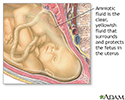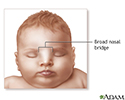Potter syndrome
Potter phenotype; Potter's syndrome
Potter syndrome and Potter phenotype refers to a group of findings associated with a lack of amniotic fluid and kidney failure in an unborn infant.
Causes
In Potter syndrome, the primary problem is kidney failure. The kidneys fail to develop properly as the baby is growing in the womb. The kidneys normally produce the amniotic fluid (as urine) that surrounds the unborn baby.
Potter phenotype refers to a typical facial appearance that occurs in a newborn when there is no amniotic fluid. The lack of amniotic fluid is called oligohydramnios. Without amniotic fluid, the infant is not cushioned from the walls of the uterus. The pressure of the uterine wall leads to an unusual facial appearance, including widely separated eyes.
Potter phenotype may also lead to abnormal limbs, or limbs that are held in abnormal positions or contractures.
Oligohydramnios also stops development of the lungs, so the lungs do not work properly at birth.
Symptoms
Symptoms include:
- Widely separated eyes with epicanthal folds, broad nasal bridge, low set ears, and receding chin
- Absence of urine output
- Difficulty breathing
Exams and Tests
A pregnancy ultrasound may show lack of amniotic fluid, absence of fetal kidneys, or severely abnormal kidneys in the unborn baby.
The following tests may be used to help diagnose the condition in a newborn:
Treatment
Resuscitation at delivery may be attempted pending the diagnosis. Treatment will be provided for any urinary outlet obstruction.
Outlook (Prognosis)
This is a very serious condition. Most of the time it is deadly. The short-term outcome depends on the severity of lung involvement. Long-term outcome depends on the severity of kidney involvement.
Prevention
There is no known prevention.
References
Miyashita Y, Formeck C, Moritz M. Nephrology. In: Zitelli BJ, McIntire SC, Nowalk AJ, Garrison J, eds. Zitelli and Davis' Atlas of Pediatric Physical Diagnosis. 8th ed. Philadelphia, PA: Elsevier; 2023:chap 14.
Marcdante KJ, Kliegman RM, Schuh AM. Congenital and developmental abnormalities of the urinary tract. In: Marcdante KJ, Kliegman RM, Schuh AM, eds. Nelson Essentials of Pediatrics. 9th ed. Philadelphia, PA: Elsevier; 2023:chap 168.
Mitchell AL. Congenital anomalies. In: Martin RJ, Fanaroff AA, Walsh MC, eds. Fanaroff and Martin's Neonatal-Perinatal Medicine. 11th ed. Philadelphia, PA: Elsevier; 2020:chap 30.
Review Date: 8/5/2023












